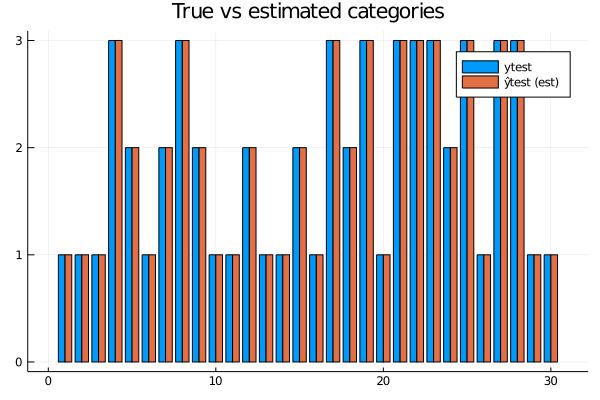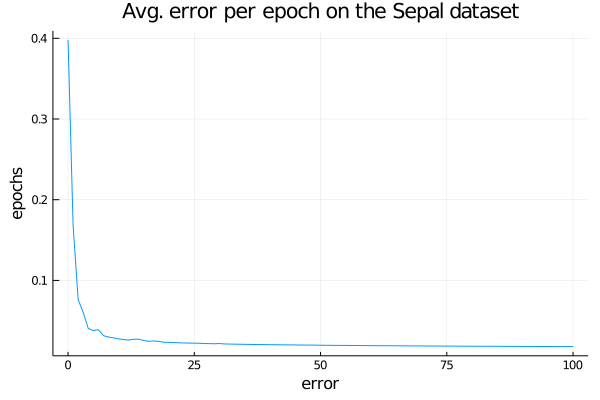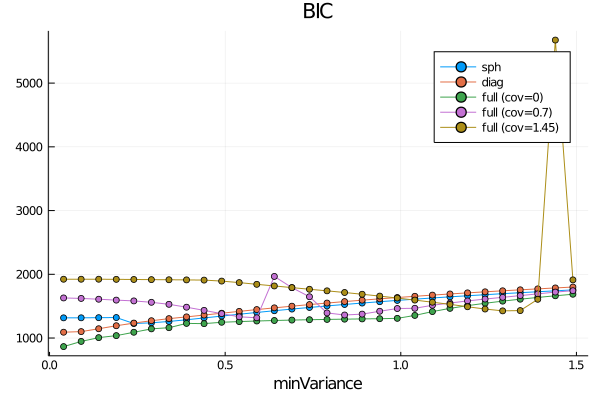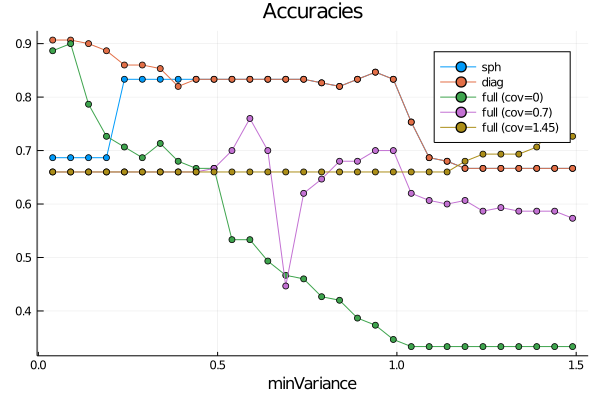 BetaML.jl Documentation
BetaML.jl Documentation
Welcome to the documentation of the Beta Machine Learning toolkit.
Installation
The BetaML package is now included in the standard Julia register, install it with:
] add BetaML
Loading the module(s)
This package is split in several submodules. You can access its functionality either by using the specific submodule of interest and then directly the provided functionality (utilities are re-exported by each of the other submodules, so normally you don't need to implicitly import them) or by using the root module BetaML and then prefix with BetaML. each object/function you want to use, e.g.:
using BetaML.Nn
myLayer = DenseLayer(2,3)or, equivalently,
using BetaML
res = BetaML.kernelPerceptron([1.1 2.1; 5.3 4.2; 1.8 1.7], [-1,1,-1])Usage
Documentation for most algorithms can be retrieved using the inline Julia help system (just press the question mark ? and then, on the special help prompt help?>, type the function name).
For a list of supported algorithms please look at the individual modules:
BetaML.Perceptron: Perform classification tasks using the Perceptron, Kernel Perceptron or Pegasus algorithmsBetaML.Nn: Implementation of Artificial Neural NetworksBetaML.Clustering`: Clustering algorithms (Kmeans, Mdedoids, EM/GMM) and missing imputation / collaborative filtering / recommandation systems using clustersBetaML.Utils`: Various utility functions (scale, one-hot, distances, kernels, pca, accuracy/error measures..)
Examples
- Using an Artificial Neural Network for multinomial categorisation
# Load Modules
using BetaML.Nn, DelimitedFiles, Random, StatsPlots # Load the main module and ausiliary modules
Random.seed!(123); # Fix the random seed (to obtain reproducible results)
# Load the data
iris = readdlm(joinpath(dirname(Base.find_package("BetaML")),"..","test","data","iris.csv"),',',skipstart=1)
iris = iris[shuffle(axes(iris, 1)), :] # Shuffle the records, as they aren't by default
x = convert(Array{Float64,2}, iris[:,1:4])
y = map(x->Dict("setosa" => 1, "versicolor" => 2, "virginica" =>3)[x],iris[:, 5]) # Convert the target column to numbers
y_oh = oneHotEncoder(y) # Convert to One-hot representation (e.g. 2 => [0 1 0], 3 => [0 0 1])
# Split the data in training/testing sets
ntrain = Int64(round(size(x,1)*0.8))
xtrain = x[1:ntrain,:]
ytrain = y[1:ntrain]
ytrain_oh = y_oh[1:ntrain,:]
xtest = x[ntrain+1:end,:]
ytest = y[ntrain+1:end]
# Define the Artificial Neural Network model
l1 = DenseLayer(4,10,f=relu) # Activation function is ReLU
l2 = DenseLayer(10,3) # Activation function is identity by default
l3 = VectorFunctionLayer(3,3,f=softMax) # Add a (parameterless) layer whose activation function (softMax in this case) is defined to all its nodes at once
mynn = buildNetwork([l1,l2,l3],squaredCost,name="Multinomial logistic regression Model Sepal") # Build the NN and use the squared cost (aka MSE) as error function
# Training it (default to ADAM)
res = train!(mynn,scale(xtrain),ytrain_oh,epochs=100,batchSize=6) # Use optAlg=SGD (Stochastic Gradient Descent) by default
# Test it
ŷtrain = predict(mynn,scale(xtrain)) # Note the scaling function
ŷtest = predict(mynn,scale(xtest))
trainAccuracy = accuracy(ŷtrain,ytrain,tol=1) # 0.983
testAccuracy = accuracy(ŷtest,ytest,tol=1) # 1.0
# Visualise results
testSize = size(ŷtest,1)
ŷtestChosen = [argmax(ŷtest[i,:]) for i in 1:testSize]
groupedbar([ytest ŷtestChosen], label=["ytest" "ŷtest (est)"], title="True vs estimated categories") # All records correctly labelled !
plot(0:res.epochs,res.ϵ_epochs, ylabel="epochs",xlabel="error",legend=nothing,title="Avg. error per epoch on the Sepal dataset")

- Using the Expectation-Maximisation algorithm for clustering
using BetaML.Clustering, DelimitedFiles, Random, StatsPlots # Load the main module and ausiliary modules
Random.seed!(123); # Fix the random seed (to obtain reproducible results)
# Load the data
iris = readdlm(joinpath(dirname(Base.find_package("BetaML")),"..","test","data","iris.csv"),',',skipstart=1)
iris = iris[shuffle(axes(iris, 1)), :] # Shuffle the records, as they aren't by default
x = convert(Array{Float64,2}, iris[:,1:4])
x = scale(x) # normalise all dimensions to (μ=0, σ=1)
y = map(x->Dict("setosa" => 1, "versicolor" => 2, "virginica" =>3)[x],iris[:, 5]) # Convert the target column to numbers
# Get some ranges of minVariance and minCovariance to test
minVarRange = collect(0.04:0.05:1.5)
minCovarRange = collect(0:0.05:1.45)
# Run the em algorithm for the various cases...
sphOut = [em(x,3,mixtures=[SphericalGaussian() for i in 1:3],minVariance=v, minCovariance=cv, verbosity=NONE) for v in minVarRange, cv in minCovarRange[1:1]]
diagOut = [em(x,3,mixtures=[DiagonalGaussian() for i in 1:3],minVariance=v, minCovariance=cv, verbosity=NONE) for v in minVarRange, cv in minCovarRange[1:1]]
fullOut = [em(x,3,mixtures=[FullGaussian() for i in 1:3],minVariance=v, minCovariance=cv, verbosity=NONE) for v in minVarRange, cv in minCovarRange]
# Get the Bayesian information criterion (AIC is also available)
sphBIC = [sphOut[v,cv].BIC for v in 1:length(minVarRange), cv in 1:1]
diagBIC = [diagOut[v,cv].BIC for v in 1:length(minVarRange), cv in 1:1]
fullBIC = [fullOut[v,cv].BIC for v in 1:length(minVarRange), cv in 1:length(minCovarRange)]
# Compare the accuracy with true categories
sphAcc = [accuracy(sphOut[v,cv].pₙₖ,y,ignoreLabels=true) for v in 1:length(minVarRange), cv in 1:1]
diagAcc = [accuracy(diagOut[v,cv].pₙₖ,y,ignoreLabels=true) for v in 1:length(minVarRange), cv in 1:1]
fullAcc = [accuracy(fullOut[v,cv].pₙₖ,y,ignoreLabels=true) for v in 1:length(minVarRange), cv in 1:length(minCovarRange)]
plot(minVarRange,[sphBIC diagBIC fullBIC[:,1] fullBIC[:,15] fullBIC[:,30]], markershape=:circle, label=["sph" "diag" "full (cov=0)" "full (cov=0.7)" "full (cov=1.45)"], title="BIC", xlabel="minVariance")
plot(minVarRange,[sphAcc diagAcc fullAcc[:,1] fullAcc[:,15] fullAcc[:,30]], markershape=:circle, label=["sph" "diag" "full (cov=0)" "full (cov=0.7)" "full (cov=1.45)"], title="Accuracies", xlabel="minVariance")

- Further examples
We also provide some Jupyter notebooks that can be run online without installing anything, so you can start playing with the library in minutes.
Acknowledgements
The development of this package at the Bureau d'Economie Théorique et Appliquée (BETA, Nancy) was supported by the French National Research Agency through the Laboratory of Excellence ARBRE, a part of the “Investissements d'Avenir” Program (ANR 11 – LABX-0002-01).
